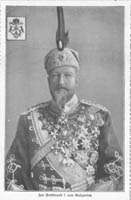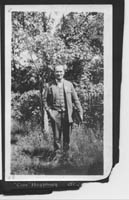Table of Contents
Media Index
CHAPTER 17
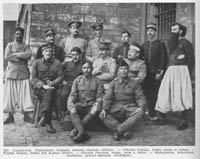
A cosmopolitan group of thirteen Allied officers, representing Belgium, Britain, France, India, and Russia, pose outdoors at the prison camp at Osnabrueck. The Gerrmans used these types of photographs for propaganda purposes to highlight Germany's death struggle with the majority of the world.
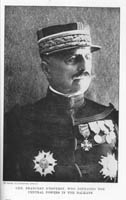
French General Franchet d'Esperey (1856-1942) commanded the Allied forces at Saloniki in 1918; his successful offensive liberated Serbia, knocked Bulgaria out of the war, and forced Austria-Hungary to sign an armistice.
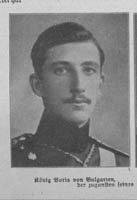
Tsar Boris III of Bulgaria (1894-1943) was the crown prince during most of World War I and became the tsar upon the abdication of his father, Tsar Ferdinand, in September 1918.
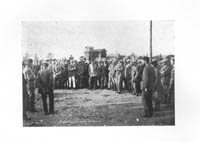
British prisoners bid their farewell to the Turkish commandant at the prison camp at Ouchak. Turkish officers stand to the extreme left and to the right in the photograph.
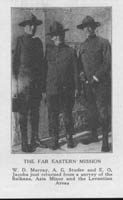
Ernst Otto Jacob (1886-1966) returned to the Near East after the war and conducted a fact-finding mission with W. D. Murray and A. G. Studer to explore YMCA expansion opportunities in the Balkans, Asia Minor, and the Levant.
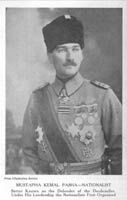
Official photograph of Mustapha Kemal Pasha (1881-1938), heroic defender of Galliopoli against the Allied attack in 1915 and leader of the nationalist forces against the Allied occupation of Asia Minor in 1919; he became the first president of Turkey.
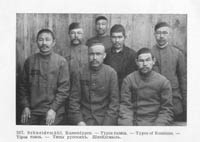
Far from home, a group of Russian prisoners representing nationalities in the Far East pose for this shot. Note the identification number on the right breast of several of the POW's.
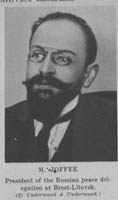
Photograph of Ioffe Joffre, the President of the Soviet delegation at the Brest-Litovsk negotiations and unofficial ambassador to Weimar Germany after the war.
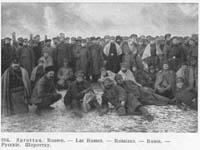
A large assembly of Russian prisoners from the four corners of the tsarist empire pose outdoors for a photograph in the compound at Sprottau near the perimeter fence. German victories in the Battle of Tannenberg and the offensive in Russian Poland resulted in a large influx of Russian POW's into Sprottau. Many of these men would remain behind barbed-wire for years after the end of the war as a result of the Russian Civil War.
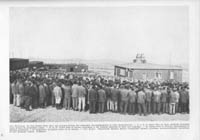
His Royal Highness Prince Max of Saxony preaches in Russian to a large group of Russian Orthodox prisoners in the prison compound at Heuberg. Note the wooden barracks in the background of the photograph.
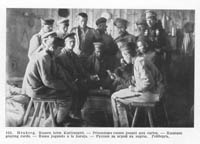
A group of Russian prisoners play a game of cards in their barrack at Heuberg using a stool as their card table. Gambling could become a serious vice in prison camps, especially since many prisoners had a lot of time on their hands and few wholesome diversions.

Russian prisoners play mandolins and violins while two POW's dance in the compound in Czersk. German non-commissioned officers watch the entertainment.
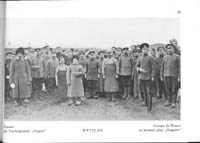
A large group of Russian prisoners captured by the Germans at Tannenberg pose with three German NCO's and a few French prisoners in the camp compound at Wetzlar. Many of the Russian POW's would not return home for years as a result of the Russian Civil War.
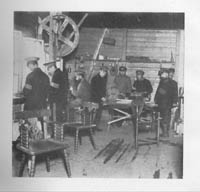
Skilled Russian carpenters work in a wood shop in the prison camp at Wahn bei Koeln. They are producing ornate chairs, including a three-legged chair to the right. Note that some of the prisoners wear red arm bands on their upper arms for identification purposes.
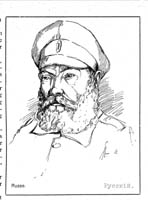
A drawing of a typical Russian POW at Muensingen. The first Russian prisoners arrived in the camp in November 1914 and many would remain at Muensingen after the Armistice of 1918.

Photograph of General George H. Harries, the chief of the U.S. Military Mission in Berlin, after the Germans signed the Armistice on the Western Front. He coordinated Allied policy regarding the post-war treatment of Russian prisoners of war in Weimar Germany,

An outbreak of typhus or cholera in a crowded prison camp could quickly result in a raging epidemic. German medical authorities isolated newly arriving prisoners and identified soldiers with infectious diseases. Russian and Romanian troops were the most notorious as carriers of typhus and cholera. The doctors sent sick patients into quarantine in special typhus/cholera barracks, such as the buildings shown here at Lamsdorf. Recovering patients are getting some air outside of the barracks in their special compound.
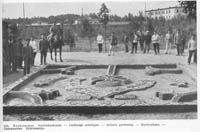
Russian prisoners-of-war stand near an artistic garden plot which depicts a German iron cross with oak leaf clusters. The garden is located near the wall which surrounded part of the prison camp at Neuhammer and a German non-commissioned officer sits on a horse.

A Russian barber conducts a brisk business cutting hair for his fellow soldiers at the prison camp in Puchheim. Barbers performed a critical sanitary service in prison camps by keeping hair short which would reduce lice infestations in crowded barracks.
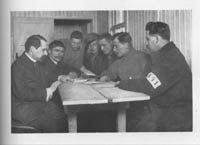
Professor H. Jakobsohn, from the University of Marburg, interviews Russian prisoners at Puchheim regarding their condition in prison. Professor Jakobsohn led the Deutsche Kommission which examined medical and labor conditions in POW camps.
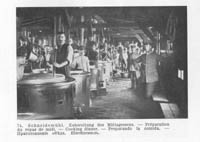
The Russian cooking staff is busy preparing a meal in the prison kitchen in Schneidemuehl under the direction of a German non-commissioned officer. Meals were mass produced in the large pressure cookers for the prison population.
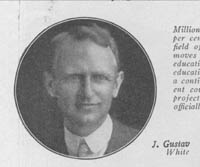
J. Gustav White (1881-1979) was an American YMCA secretary who served as a WPA Secretary in Germany from 1916 to 1917; he then transferred to Geneva where he became the Education Secretary for the World's Alliance of YMCA's.
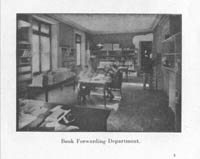
World Alliance secretaries prepare books for shipment to prisoners of war in Allied and Central Power prison camps from the Geneva headquarters. Prisoners could request books, usually Scriptures or religious tracts, directly from the World's Alliance. Rudolf Horner directed the Book Forwarding Department for the World's Alliance.
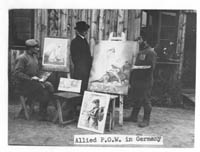
Two Russian prisoners of war show their paintings to an unidentified YMCA secretary during a visit to an unidentified German prison camp. Angels appearing from heaven on the battlefield are the themes of both paintings on the easel. The YMCA provided art supplies to prisoners to encourage them to paint. POW's often displayed their art work at POW exhibitions and sold their art in neutral countries to earn some money.
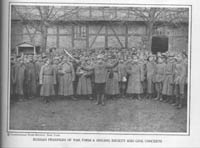
These Russian prisoners of war formed a singing society and performed concerts for their fellow POW's. They are standing in the prison compound of an unidentified prison camp, outside one of the barracks.
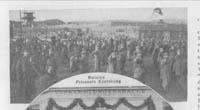
Russian prisoners exercise en masse in the compound of an unidentified German prison camp. Callisthenics helped keep the prisoners in shape and improved camp morale.
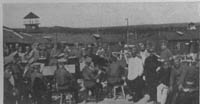
Russian prisoners of war in an unidentified German prison camp perform in a prison compound. These men are members of the YMCA Orchestra. The Red Triangle provided their musical instruments and their music. By providing instruments, the Association was able to support entertainment programs, often featuring talented musicians.
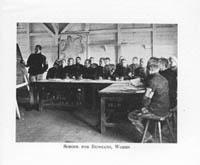
Prisoners of war at Worms sit in a classroom reviewing a math lesson. The instructor is a prisoners as well and the students work out problems on small chaukboards at their benches. The original caption for this picture indicated that this was a school for Russian prisoners and a map of European Russia is mounted on the wall in the back of the classroom. The YMCA provided educational materials for prisoners so they could continue their educations during their time in prison.

While in captivity, a number of POW's took advantage of the opportunity to attend classes at Muensingen. In this wood block print, a teacher lectures a room of prisoners sitting at their desks.
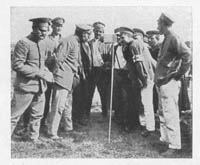
Russian prisoners inspect a box camera mounted on a tripod outdoors in the prison compound at Grafenwoehr.
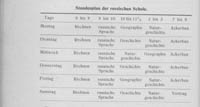
Russian prisoners had the opportunity to continue their educations in the prison camp school at Muensingen. This weekly lesson plan outlines the courses POW's attended and the curriculum included topics such as arithmetic, reading, geography, history, natural science, and agriculture. The goal was to improve the individual soldier during his incarceration during the war.
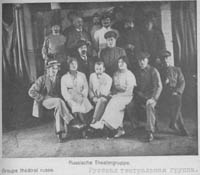
Plays and theatrical performances allowed prisoners to develop their thespian skills and provided the general camp population with a source of entertainment. This photograph shows a Russian cast, which includes two men dressed in female roles, posing inside the theater at Muensingen.
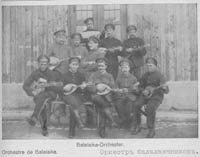
Musical performances lifted spirits within prison camps and this photo shows a Russian POW balalaika orchestra at Muensingen.
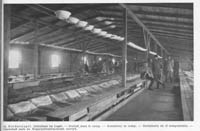
Russian POW's and a few civilian internees (in the back row) stand in their barrack at Norderstapel. The accommodations are very cramped and spartan. With benches aligning the two dormitory aisles, inmates enjoy little privacy, especially with their adjoined bunks. There are few prisoner possessions in the photograph. Note the large bowls suspended by wires above the bunks.
